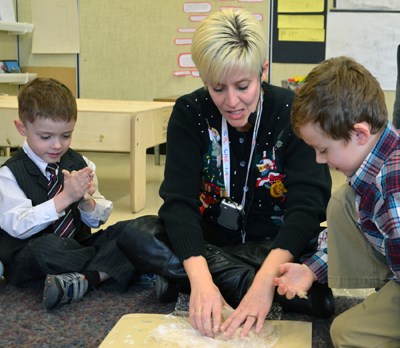Self-regulation is the cornerstone of early learning. Being able to control emotions, behaviour and attention in a group is a building block for success in learning and in life.
In early learning – kindergarten in Rainbow Schools, children are provided with many opportunities to identify and solve problems within their own classrooms.
How many people can play at a learning centre? How should the learning materials be used? What do you do if you need help?
From the Early Learning Kindergarten Program document comes this quote from Charles Pascal, “Self-regulation is not about compliance. It is about establishing one’s internal motivation for adapting to and understanding emotional and social demands.”
In the past, adults took ownership for decisions made in the classroom. Now, they turn it around so children are actively involved in the decision-making process.
“The result is that children are more willing and able to solve many of the problems they encounter,” said Sharon Speir, the superintendent responsible for early learning – kindergarten in Rainbow Schools. “In the process, they develop self-regulation skills.”
Darlene Villeneuve, an early learning – kindergarten teacher at Redwood Acres Public School, described how she and early childhood educator Brigitte Labrie used an opportunity that presented itself in the classroom to work on self-regulation.
“During play times, we noticed children saying, ‘That’s not fair!’ As adults, we could easily step in and tell children what to do in order to make a situation fair. But would that solve the problem? Would the children understand what fair means?” Villeneuve said.
Instead of stepping in, educators presented the children with scenarios they encounter each day during play. They gave them an opportunity to talk as a group and create their own interpretation of what is fair.
Taking a ball of play dough, the teacher invited a child to join her. As the teacher created a figure, she began talking aloud about how much she loved working with the cinnamon-scented dough.
The child she invited to play said he wanted to make a dinosaur. After a few minutes of the teacher working silently as the children observed, students said, “Hey! That’s not fair!”
The teacher asked how she could be fair and the children responded that she needed to give the child some dough. The teacher gave the child a small piece and continued working.
Once again, the children protested, saying, “That’s still not fair. He needs to have half.”
The educators came to a number of conclusions that day. Fair means sharing. Fair means listening to your friend. Fair means giving the other person half of the dough.
How often do we as adults want to step in to help children complete a task or solve a problem?
Next time, observe and listen. You will soon discover that young children not only want to solve problems on their own, they can solve problems on their own.
Rainbow Schools are hosting information nights for junior and senior kindergarten classes this month. Visit rainbowschools.ca for more information.
In the next column, we will look at French Immersion in a play-based environment.
Norm Blaseg is Director of Education for Rainbow District School Board.
Join Sudbury.com+
- Messages
- Post a Listing
- Your Listings
- Your Profile
- Your Subscriptions
- Your Likes
- Your Business
- Support Local News
- Payment History
Sudbury.com+ members
Already a +member?
Not a +member?
Sign up for a Sudbury.com+ account for instant access to upcoming contests, local offers, auctions and so much more.
